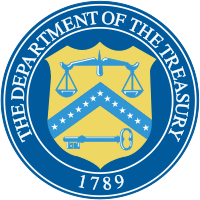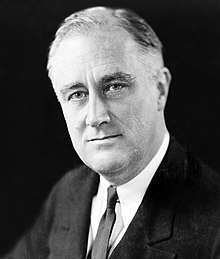Henry Morgenthau Jr.
Henry Morgenthau Jr. (/ˈmɔːrɡənθɔː/; May 11, 1891 – February 6, 1967) was the United States Secretary of the Treasury during most of the administration of Franklin D. Roosevelt. He played a major role in designing and financing the New Deal. After 1937, while still in charge of the Treasury, he played the central role in financing United States participation in World War II.[1] He also played an increasingly major role in shaping foreign policy, especially with respect to Lend-Lease, support for China, helping Jewish refugees, and proposing (in the "Morgenthau Plan") to prevent Germany from again being a military threat by wrecking its industry and mines.[2]
Henry Morgenthau Jr. | |
|---|---|
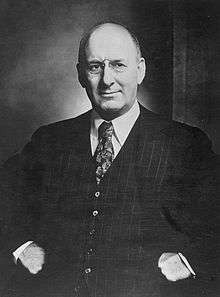 | |
| 52nd United States Secretary of the Treasury | |
| In office January 1, 1934 – July 22, 1945 | |
| President | Franklin D. Roosevelt Harry S. Truman |
| Preceded by | William H. Woodin |
| Succeeded by | Fred M. Vinson |
| Personal details | |
| Born | May 11, 1891 New York City, New York, U.S. |
| Died | February 6, 1967 (aged 75) Poughkeepsie, New York, U.S. |
| Political party | Democratic |
| Spouse(s) | Elinor Fatman |
| Children | Henry Morgenthau III, Robert Morgenthau & Joan Morgenthau Hirschhorn |
| Education | Cornell University (BS) |
| Signature | |
Morgenthau was the father of Robert M. Morgenthau, who was District Attorney of Manhattan for 35 years and Henry Morgenthau III, an American author and television producer. He continued as Treasury secretary through the first few months of Harry Truman's presidency, and from June 27, 1945 to July 3, 1945, following the resignation of Secretary of State Edward Stettinius Jr., was next in line to the presidency. Morgenthau was thus the first Jew to be in the presidential line of succession.[3][4][5]
Early life
Morgenthau was born into a prominent Jewish family in New York City, the son of Josephine (Sykes) and Henry Morgenthau Sr., a real estate mogul and diplomat. His parents were born in Germany. He had three sisters. He attended Phillips Exeter Academy, later transferring to the Dwight School. He then studied architecture and agriculture at Cornell University. In 1913, he met and became friends with Franklin and Eleanor Roosevelt. He operated a farm named Fishkill Farms near the Roosevelt estate in upstate New York, specializing, like FDR, in growing Christmas trees.[6] He was concerned about distress among farmers, who comprised over a fourth of the population. In 1922, he took over the American Agriculturalist magazine, making it a voice for reclamation, conservation, and scientific farming.[2] In 1929, Roosevelt, as Governor of New York, appointed him chair of the New York State Agricultural Advisory Committee and to the state Conservation Commission.
New Deal
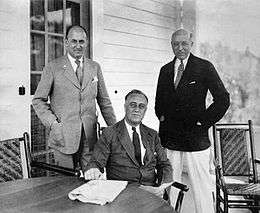
In 1933, Roosevelt became President and appointed Morgenthau governor of the Federal Farm Board. Morgenthau was nonetheless involved in monetary decisions. Roosevelt adopted the idea of raising the price of gold to inflate the currency and reverse the debilitating deflation of prices. The idea came from Professor George Warren of Cornell University. Morgenthau wrote in his diary:
Saturday — Went to the White House and met Jones there. I said to the President that we did not buy any gold last night. He said, "That is right. Harrison called up and spoke to Jesse." I could not make out whether he also spoke to the President. Then Harrison urged that inasmuch as Saturday was only half a day that they should not buy any gold. Both the President and Jones said that they thought they made a mistake by agreeing with Harrison. I believe it was on Friday that we raised the price 21¢, and the President said, "It is a lucky number because it is three times seven." If anybody ever knew how we really set the gold price through a combination of lucky numbers, etc., I think that they really would be frightened. Saturday we increased the price 10¢. I stayed after Jones left and had a good half hour talk in which most of the time Louis Howe was present.[7]
In 1934, when William H. Woodin resigned because of poor health, Roosevelt appointed Morgenthau Secretary of the Treasury; even conservatives approved.[8] Morgenthau was a strict monetarist. President Roosevelt, Morgenthau, and Federal Reserve Chairman Marriner Stoddard Eccles jointly kept interest rates low during the depression to finance massive public spending, and then later to support rearmament, support for Britain, and U.S. participation in WW II.[9][10][11]
In 1934, President Franklin D. Roosevelt asked Morgenthau to examine the taxes of William Randolph Hearst because FDR was "advised that Hearst was planning to use his newspapers to launch a major attack on the New Deal and its economic policies."[12] Treasury Secretary Morgenthau explained that he examined the taxes of William Randolph Hearst and actress Marion Davies and "advised FDR to mount a preemptive attack on both her and Hearst."[12][13]
Campaign against corruption
Morgenthau used his position as Treasury chief to investigate organized crime and government corruption. Treasury Intelligence and other agencies (the notoriously fragmented United States federal law enforcement system had five in the Treasury Department alone) were uncoordinated in their efforts; efforts to create a super-agency were stalled by J. Edgar Hoover, who feared his FBI would be overshadowed. Nevertheless, Morgenthau created a coordinator for the Treasury agencies; although the coordinator could not control them, he could move them to some cooperation.
Former head of IRS' criminal investigators Elmer Lincoln Irey, who had directed major investigations including the successful prosecution of Al Capone, assumed the position in 1937. Investigations of official corruption caused the fall of political boss Thomas "Big Tom" Pendergast of Kansas City. A Mafia-related shootout and massive official corruption led to successful investigations against Pendergast and the local Mafia head Charles Carrollo.[14] Other officials — as well as gangsters, in a few rare cases — were convicted because of Morgenthau's investigations.
Fiscal responsibility
Morgenthau believed in balanced budgets, stable currency, reduction of the national debt, and the need for more private investment. The Wagner Act regarding labor unions met Morgenthau's requirement, because it strengthened the party's political base and involved no new spending. Morgenthau accepted Roosevelt's double budget as legitimate — that is, a balanced regular budget, and an "emergency" budget for agencies, like the Works Progress Administration (WPA), Public Works Administration (PWA) and Civilian Conservation Corps (CCC), that would be temporary until full recovery was at hand. He fought against the veterans' bonus until Congress finally overrode Roosevelt's veto and gave out $2.2 billion in 1936. In the 1937 "Depression within the Depression", Morgenthau was unable to persuade Roosevelt to desist from continued deficit spending. Roosevelt continued to push for more spending, and Morgenthau promoted a balanced budget. In 1937, however, Morgenthau successfully convinced Roosevelt to finally focus on balancing the budget through major spending cuts and tax increases; Keynesian economists have argued that this new attempt by Roosevelt to balance the budget created the Recession of 1937–1938.[15] On November 10, 1937, Morgenthau gave a speech to the Academy of Political Science at New York's Hotel Astor, in which he noted that the Depression had required deficit spending, but that the government needed to cut spending to revive the economy. In his speech, he said:[16]
We want to see private business expand. ... We believe that one of the most important ways of achieving these ends at this time is to continue progress toward a balance of the federal budget.
His biggest success was the new Social Security program; he reversed the proposals to fund it from general revenue and insisted it be funded by new taxes on employees. Morgenthau insisted on excluding farm workers and domestic servants from Social Security because workers outside industry would not be paying their way.[17] He questioned the value of the deficit spending that had not reduced unemployment and only added debt:[18]
We have tried spending money. We are spending more than we have ever spent before and it does not work. And I have just one interest, and if I am wrong ... somebody else can have my job. I want to see this country prosperous. I want to see people get a job. I want to see people get enough to eat. We have never made good on our promises. ... I say after eight years of this Administration we have just as much unemployment as when we started. ... And an enormous debt to boot.[19]
To reduce the deficit he argued for increased taxes, particularly on the wealthy.
We have never begun to tax the people in this country the way they should be ... I don't pay what I should. People in my class don't. People who have it should pay.[19]
Jewish refugees
Once confronted by The Holocaust, the Allied Powers reacted slowly. In 1943, Morgenthau's Treasury Department approved the World Jewish Congress' plan to rescue Jews through the use of blocked accounts in Switzerland, but the State Department and the British Foreign Office procrastinated further. Morgenthau and his staff persisted in bypassing State and ultimately confronting Roosevelt in January 1944 with the Report to the Secretary on the Acquiescence of This Government in the Murder of the Jews. He obtained the presidential creation of the United States War Refugee Board (WRB) in January 1944. The Board sponsored the Raoul Wallenberg mission to Budapest and allowed an increasing number of Jews to enter the U.S. in 1944 and 1945; as many as 200,000 Jews were saved in this way.[20]
Hurwitz (1991) argues that in late 1943, the Treasury Department drafted a report calling for the creation of a special rescue agency for European Jewry. At the same time, several congressmen connected with the "Bergson Boys" introduced a resolution also calling for the creation of such an agency. On January 16, 1944, Morgenthau presented Roosevelt with the Treasury report, and the president agreed to create the War Refugee Board, the first major attempt of the United States to deal with the annihilation of European Jews.
Blum argues that by mid-1944, the War Refugee Board:
Had begun to fulfill Morgenthau's high expectations. His experience in getting the board established and in helping to oversee its operations constituted his signal wartime success to that date in nurturing humanitarian purpose in American foreign-policy.[21]
As for the top Germans, Morgenthau at one point in summer 1944 suggested to Roosevelt that the top 50 or 100 German "arch-criminals" should be shot upon capture. He changed his mind and by early 1945 proposed formal trials.[22]
The Morgenthau Plan
In 1944, Morgenthau proposed the Morgenthau Plan for postwar Germany, calling for Germany to lose its heavy industry, and the Ruhr "should not only be stripped of all presently existing industries, but so weakened and controlled that it can not in the foreseeable future become an industrial area".[23] Germany would keep its rich farmlands in the east. However Stalin insisted on the Oder-Neisse border, which moved those farming areas out of Germany. Therefore, the original Morgenthau plan had to be dropped, Weinberg argues, because it was "too soft on the Germans, not too hard as some still imagine."[24]
At the Second Quebec Conference on September 16, 1944, Roosevelt and Morgenthau persuaded the initially very reluctant British Prime Minister Winston Churchill to agree to the Morgenthau Plan, likely using a $6 billion Lend-Lease agreement to do so.[25] Churchill chose however to narrow the scope of Morgenthau's proposal by drafting a new version of the memorandum, which ended up being the version signed by the two statesmen.[25] The gist of the signed memorandum was "This programme for eliminating the war-making industries in the Ruhr and the Saar is looking forward to converting Germany into a country primarily agricultural and pastoral in its character."
The plan faced opposition in Roosevelt's cabinet, primarily from Henry L. Stimson, and when the plan was leaked to the press, there was public criticism of Roosevelt.[26] The President's response to inquiries was to deny the press reports.[27] As a consequence of the leak, Morgenthau was in bad favor with Roosevelt for a time.
German Propaganda Minister Joseph Goebbels used the leaked plan, with some success, to encourage the German people to persevere in their war efforts so that their country would not be turned into a "potato field."[28] General George Marshall complained to Morgenthau that German resistance had strengthened.[29] Hoping to get Morgenthau to relent on his plan for Germany, Roosevelt's son-in-law, Lt. Colonel John Boettiger, who worked in the United States Department of War, explained to Morgenthau how the American troops had had to fight for five weeks against fierce German resistance to capture Aachen and complained to him that the Morgenthau Plan was "worth thirty divisions to the Germans." In late 1944, Roosevelt's election opponent, Thomas E. Dewey, said it was worth "ten divisions". Morgenthau refused to relent.[30]
On May 10, 1945, Truman signed the U.S. occupation directive JCS 1067. Morgenthau told his staff that it was a big day for the Treasury, and that he hoped that "someone doesn't recognize it as the Morgenthau Plan."[31] The directive, which was in effect for over two years directed the U.S. forces of occupation to "... take no steps looking toward the economic rehabilitation of Germany".[32]
In occupied Germany Morgenthau left a direct legacy through what in OMGUS commonly were called "Morgenthau boys". These were U.S. Treasury officials whom General Dwight D. Eisenhower had "loaned" in to the Army of occupation. These people ensured that JCS 1067 was interpreted as strictly as possible. They were most active in the first crucial months of the occupation, but continued their activities for almost two years following the resignations of Morgenthau in mid-1945, and some time later, of their leader, Colonel Bernard Bernstein, who was "the repository of the Morgenthau spirit in the army of occupation".[33] They resigned when, in July 1947, JCS 1067 was replaced by JCS 1779, which instead stressed that "An orderly, prosperous Europe requires the economic contributions of a stable and productive Germany."
Morgenthau's legacy was also seen in the plans for preserving German disarmament by significantly reducing German economic might.[34] (see also Allied plans for German industry after World War II)
In October 1945, Morgenthau published a book titled Germany is Our Problem in which he described and motivated the Morgenthau plan in great detail.[35] Roosevelt had granted permission for the book the evening before his death, when dining with Morgenthau at Warm Springs. Morgenthau had asked Churchill for permission to also include the text of the then still secret "pastoralization" memorandum signed by Churchill and FDR at Quebec but permission was denied.[36] In November 1945 General Dwight D. Eisenhower, the Military Governor of the U.S. Occupation Zone, approved the distribution of 1000 free copies of the book to American military officials in occupied Germany. Historian Stephen E. Ambrose draws the conclusion that, despite Eisenhower's later claims that the act was not an endorsement of the Morgenthau plan, Eisenhower both approved of the plan and had previously given Morgenthau at least some of his ideas on how Germany should be treated.[37]
Following his resignation, along with other prominent individuals such as the former first lady, Eleanor Roosevelt, Morgenthau remained for several years an active member of the group campaigning for a "harsh peace" for Germany.[38] Ultimately though, the policy of re-integrating a fully industrialized and de-Nazified modern Germany into Europe was the policy adopted, as described in Frank Capra's influential 1945 short subject "Here is Germany".
Bretton Woods
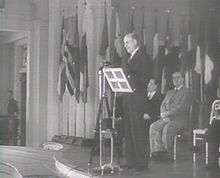
Morgenthau was first appointed by the U.S. President Franklin D. Roosevelt as temporary President of the Bretton Woods Conference, which established the Bretton Woods system, the International Monetary Fund and the International Bank for Reconstruction and Development (the World Bank). During the inaugural plenary session on July 1, 1944, the Head of the Mexican Delegation, Eduardo Suarez, nominated him as Permanent President of the Conference. This motion was seconded by the Brazilian Head Delegate, Arthur de Souza Costa, and widely supported by several other delegations such as the Canadian and Soviet ones.
Later career and legacy
In 1945, when Harry S. Truman became President, Morgenthau insisted on accompanying Truman to Potsdam by threatening to quit if he was not allowed to; Truman accepted his resignation immediately.[39] He devoted the remainder of his life to working with Jewish philanthropies, and also became a financial advisor to Israel. Tal Shahar, an Israeli moshav (agricultural community) near Jerusalem, created in 1948, was named in his honor (Morgenthau (modern spelling Morgentau) means "morning dew" in German, and so does "Tal Shahar" in Hebrew).
Morgenthau donated his diary of 840 volumes to the Franklin D. Roosevelt Presidential Library and Museum.[40] He died in Poughkeepsie, New York, in 1967. His son Robert M. Morgenthau was the District Attorney of New York County from 1975 to 2009.
The 378-foot (115 m) United States Coast Guard Hamilton-class cutter USCGC Morgenthau (WHEC-722) was named in his honor. The ship was sold to Vietnam Coast Guard as CSB-8020.
Personal life
He was married to Elinor Lehman Fatman, granddaughter of Mayer Lehman, a co-founder of Lehman Brothers; they had three children — Joan Morgenthau Hirschhorn, married to Fred Hirschhorn Jr.; Henry Morgenthau III, and Robert M. Morgenthau.[41] In 1913, Morgenthau purchased a farm in Hopewell Junction, New York, naming it Fishkill Farms. The farm still belongs to the Morgenthau family.
Notes
- Herman, Arthur. Freedom's Forge: How American Business Produced Victory in World War II, pp. 9–11, 125–7, Random House, New York, NY, 2012. ISBN 978-1-4000-6964-4.
- May 2000.
- "Succession to the Presidency". CQ Researcher by CQ Press.
- Hugh E. Evans (2002). The Hidden Campaign: FDR's Health and the 1944 Election. M.E. Sharpe. p. 125. ISBN 978-0-7656-0855-0.
henry morgenthau first in line to presidency.
- "Henry Morgenthau, Jr., U.S. Secretary of the Treasury". geni_family_tree.
- Goldberg, Richard Thayer (1981). The making of Franklin D. Roosevelt: triumph over disability. p. 116. ISBN 978-0-89011-564-0. LCCN 81017555.
- "Image – p.96" (PDF).
- John Morton Blum, From the Morgenthau Diaries: Years of Crisis, 1928–1938. Vol. 1 (1959) p 74.
- Rothbard, Murray N. "The Origins of the Federal Reserve" (PDF).
- "A History of Central Banking in the United States". the Federal Reserve Bank of Minneapolis. Archived from the original on 2009-12-29.
- "Obituary: William McChesney Martin". 21 August 1998.
- Thorndike, Joseph J. (August 23, 2012). "Tax Troubles of the Rich and Famous, 1930s Edition – 2012 TNT 166-3". Tax Analysts.
- Nasaw, David (September 6, 2001). The Chief: The Life of William Randolph Hearst. 500: Mariner Books. p. 704. ISBN 978-0-618-15446-3.CS1 maint: location (link)
- Repetto 2004.
- Krugman, Paul (November 8, 2008). "New Deal economics". The New York Times. Retrieved 2012-04-30.
- Shlaes 2007, p. 341–342.
- Zelizer 2000.
- Blum, John Morton (1970). Roosevelt and Morgenthau. Boston, Massachusetts: Houghton Mifflin Harcourt. p. 256. LCCN 75096063. OCLC 68158.
- Morgenthau, Henry Jr. (May 9, 1939). Henry Morgenthau Diary, Microfilm Roll #50 (PDF, 1.9 MB).
- Penkower 1980.
- John Morton Blum, From the Morgenthau Diaries: Years of War 1941–1945 (1967) p 227
- Blum, From the Morgenthau Diaries: Years of War 1941–1945 (1967) p 397
- Morgenthau. "Suggested Post-Surrender Program for Germany". Archived from the original on 2013-05-31.
- Gerhard L. Weinberg (2005). Visions of Victory: The Hopes of Eight World War II Leaders. Cambridge University Press. p. 183.
- Chase, John L. (May 1954). "The Development of the Morgenthau Plan Through the Quebec Conference". The Journal of Politics. 16 (2): 324–359. doi:10.2307/2126031. JSTOR 2126031.
- "The Policy of Hate". Time. October 2, 1944. Retrieved 2012-04-30.
- "The Battle for Peace Terms". Time. October 9, 1944. Retrieved 2012-04-30.
- "Office of Strategic Services — Official Dispatch, Ref. No. 250". Franklin D. Roosevelt Presidential Library and Museum, Marist College. Retrieved 2012-04-30.
- Report on the Morgenthau Diaries, p. 41ff
- Beschloss 2002, p. 172–173.
- Beschloss 2002, p. 233.
- "CONFERENCES: Pas de Pagaille!". Time. July 28, 1947. Retrieved 2012-04-30.
- Petrov 1967, p. 228–229.
- Gareau, Frederick H. (June 1961). "Morgenthau's Plan for Industrial Disarmament in Germany". The Western Political Quarterly. University of Utah. 14 (2): 517–534. doi:10.2307/443604. JSTOR 443604.
- Germany Is Our Problem. Harper and Brothers, 1945
- Beschloss 2002, p. 250.
- Ambrose, Stephen E. (1983). Eisenhower: Soldier, General of the Army, President-Elect (1893–1952). New York: Simon & Schuster. p. 422. ISBN 978-0-671-44069-5. LCCN 83009892.
- Casey, Steven (2005). "The campaign to sell a harsh peace for Germany to the American public, 1944–1948" (PDF, 0.4 MB). History. Volume 90, Issue 297, pages 62–92, January 2005. 90 (297): 62–92. doi:10.1111/j.1468-229X.2005.00323.x.
- Jansohn, Col(GS) Uwe F. (January 2013). "PRESIDENT TRUMAN AND (THE CHALLENGE OF)THE POTSDAM CONFERENCE 1945" (PDF). Retrieved 2020-05-20.
- Gunther, John (1950). Roosevelt in Retrospect. Harper & Brothers. pp. 102.
- New York Times: "Joan Morgenthau Hirschhorn" October 7, 2012
References
- Beschloss, Michael (2002). The Conquerors: Roosevelt, Truman and the Destruction of Hitler's Germany, 1941–1945. Simon & Schuster. ISBN 978-0-684-81027-0. LCCN 2002030331.CS1 maint: ref=harv (link) Devotes much attention to Morgenthau Plan
- Hurwitz, Ariel (1991). "The Struggle over the Creation of the War Refugee Board (WRB)". Holocaust and Genocide Studies. 6 (1): 17–31. doi:10.1093/hgs/6.1.17.CS1 maint: ref=harv (link)
- Irey, Elmer Lincoln (1948). The Tax Dodgers: The Insider Story of the T-Men's War with America's Political and Underworld Hoodlums. Greenburg. ASIN B002DIUAAW.CS1 maint: ref=harv (link)
- May, Dean L. (1981). From New Deal to New Economics: The American Liberal Response to the Recession of 1937. ISBN 978-0-8240-4862-4. LCCN 80008466.CS1 maint: ref=harv (link)
- May, Dean L. (2000). Morgenthau, Henry Jr. American National Biography. Oxford University Press.CS1 maint: ref=harv (link)
- Penkower, Monty Noam (1980). "Jewish Organizations and the Creation of the U.S. War Refugee Board". Annals of the American Academy of Political and Social Science. 450 (1): 122–139. doi:10.1177/000271628045000111.CS1 maint: ref=harv (link)
- Petrov, Vladimir Nikolayevich (1967). Money and Conquest: Allied Occupation Currencies in World War II. Baltimore, Maryland: Johns Hopkins Press. ISBN 978-0-8018-0530-1. LCCN 66026685. OCLC 186795.CS1 maint: ref=harv (link)
- Repetto, Thomas (2004). The American Mafia: A History of Its Rise to Power. Henry Holt & Company. ISBN 978-0-8050-7210-5. LCCN 2003056736.CS1 maint: ref=harv (link)
- Brands, H. W. (October 2011). Greenback Planet: How the Dollar Conquered the World and Threatened Civilization as We Know It. Discovering America. pp. 54, 55. ISBN 978-0-292-72341-2.CS1 maint: ref=harv (link)
- Schlesinger, Arthur M. Jr. (1957–1960). The Age of Roosevelt, vol. I–III. LCCN 56010293.CS1 maint: ref=harv (link)
- Moreira, Peter (2014). The Jew Who Defeated Hitler: Henry Morgenthau Jr., FDR, and How We Won the War. ISBN 978-1-61614-958-1.CS1 maint: ref=harv (link)
- Zelizer, Julian E. (June 2000). "The Forgotten Legacy of the New Deal: Fiscal Conservatism and the Roosevelt Administration, 1933–1938". Presidential Studies Quarterly. 30 (2): 331–358. doi:10.1111/j.0360-4918.2000.00115.x. JSTOR 27552097.CS1 maint: ref=harv (link)
Primary sources
- Blum, John Morton, ed. From the Morgenthau Diaries, a 3-volume narrative of Morgenthau's New Deal years (1928–45) based very closely on his diary.; abridged edition: Roosevelt and Morgenthau: A Revision and Condensation of From the Morgenthau Diaries (1970)
External links
| Wikimedia Commons has media related to Henry Morgenthau, Jr.. |
- Time Magazine October 15, 1945 Morgenthau's Hope Reaction to the publication of Morgenthau's book "Germany is Our Problem" where he promotes the "Morgenthau Plan".
- Time Magazine September 22, 1967 Vengeance v. Vision Review of Years of War, 1941–1945; From the Morgenthau Diaries by John Morton Blum.
- U.S. Treasury – Biography of Secretary Morgenthau
- Stay the Hand of Vengeance by Gary Bass
- Newspaper clippings about Henry Morgenthau Jr. in the 20th Century Press Archives of the ZBW
| Political offices | ||
|---|---|---|
| Preceded by William H. Woodin |
U.S. Secretary of the Treasury Served under: Franklin D. Roosevelt, Harry S. Truman 1934–1945 |
Succeeded by Fred M. Vinson |
